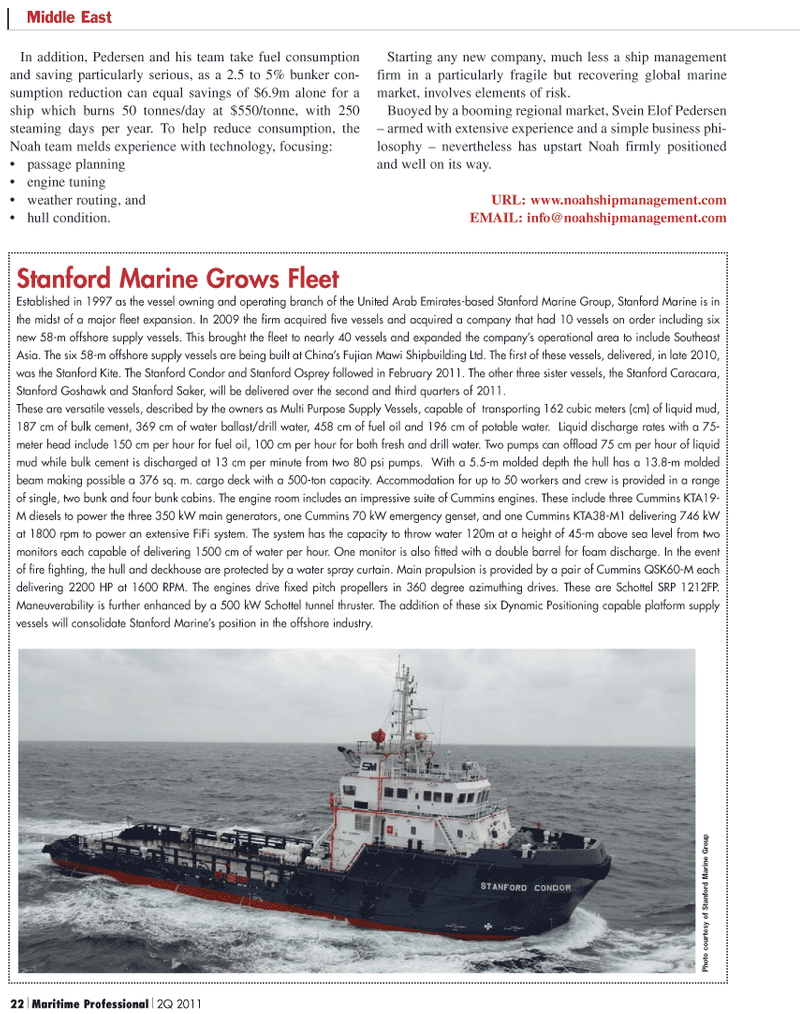
Page 22: of Maritime Logistics Professional Magazine (Q2 2011)
Energy Transportation
Read this page in Pdf, Flash or Html5 edition of Q2 2011 Maritime Logistics Professional Magazine
22 Maritime Professional 2Q 2011
Middle East
In addition, Pedersen and his team take fuel consumption and saving particularly serious, as a 2.5 to 5% bunker con- sumption reduction can equal savings of $6.9m alone for a ship which burns 50 tonnes/day at $550/tonne, with 250 steaming days per year. To help reduce consumption, the
Noah team melds experience with technology, focusing: • passage planning • engine tuning • weather routing, and • hull condition.
Starting any new company, much less a ship management firm in a particularly fragile but recovering global marine market, involves elements of risk.
Buoyed by a booming regional market, Svein Elof Pedersen – armed with extensive experience and a simple business phi- losophy – nevertheless has upstart Noah firmly positioned and well on its way.
URL: www.noahshipmanagement.com
EMAIL: [email protected]
Stanford Marine Grows Fleet
Established in 1997 as the vessel owning and operating branch of the United Arab Emirates-based Stanford Marine Group, Stanford Marine is in the midst of a major fleet expansion. In 2009 the firm acquired five vessels and acquired a company that had 10 vessels on order including six new 58-m offshore supply vessels. This brought the fleet to nearly 40 vessels and expanded the company’s operational area to include Southeast
Asia. The six 58-m offshore supply vessels are being built at China’s Fujian Mawi Shipbuilding Ltd. The first of these vessels, delivered, in late 2010, was the Stanford Kite. The Stanford Condor and Stanford Osprey followed in February 2011. The other three sister vessels, the Stanford Caracara,
Stanford Goshawk and Stanford Saker, will be delivered over the second and third quarters of 2011.
These are versatile vessels, described by the owners as Multi Purpose Supply Vessels, capable of transporting 162 cubic meters (cm) of liquid mud, 187 cm of bulk cement, 369 cm of water ballast/drill water, 458 cm of fuel oil and 196 cm of potable water. Liquid discharge rates with a 75- meter head include 150 cm per hour for fuel oil, 100 cm per hour for both fresh and drill water. Two pumps can offload 75 cm per hour of liquid mud while bulk cement is discharged at 13 cm per minute from two 80 psi pumps. With a 5.5-m molded depth the hull has a 13.8-m molded beam making possible a 376 sq. m. cargo deck with a 500-ton capacity. Accommodation for up to 50 workers and crew is provided in a range of single, two bunk and four bunk cabins. The engine room includes an impressive suite of Cummins engines. These include three Cummins KTA19-
M diesels to power the three 350 kW main generators, one Cummins 70 kW emergency genset, and one Cummins KTA38-M1 delivering 746 kW at 1800 rpm to power an extensive FiFi system. The system has the capacity to throw water 120m at a height of 45-m above sea level from two monitors each capable of delivering 1500 cm of water per hour. One monitor is also fitted with a double barrel for foam discharge. In the event of fire fighting, the hull and deckhouse are protected by a water spray curtain. Main propulsion is provided by a pair of Cummins QSK60-M each delivering 2200 HP at 1600 RPM. The engines drive fixed pitch propellers in 360 degree azimuthing drives. These are Schottel SRP 1212FP.
Maneuverability is further enhanced by a 500 kW Schottel tunnel thruster. The addition of these six Dynamic Positioning capable platform supply vessels will consolidate Stanford Marine’s position in the offshore industry.
Photo cour tesy of Stanfor d Marine Gr oup

 21
21

 23
23
